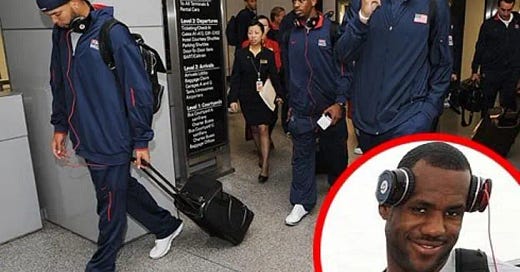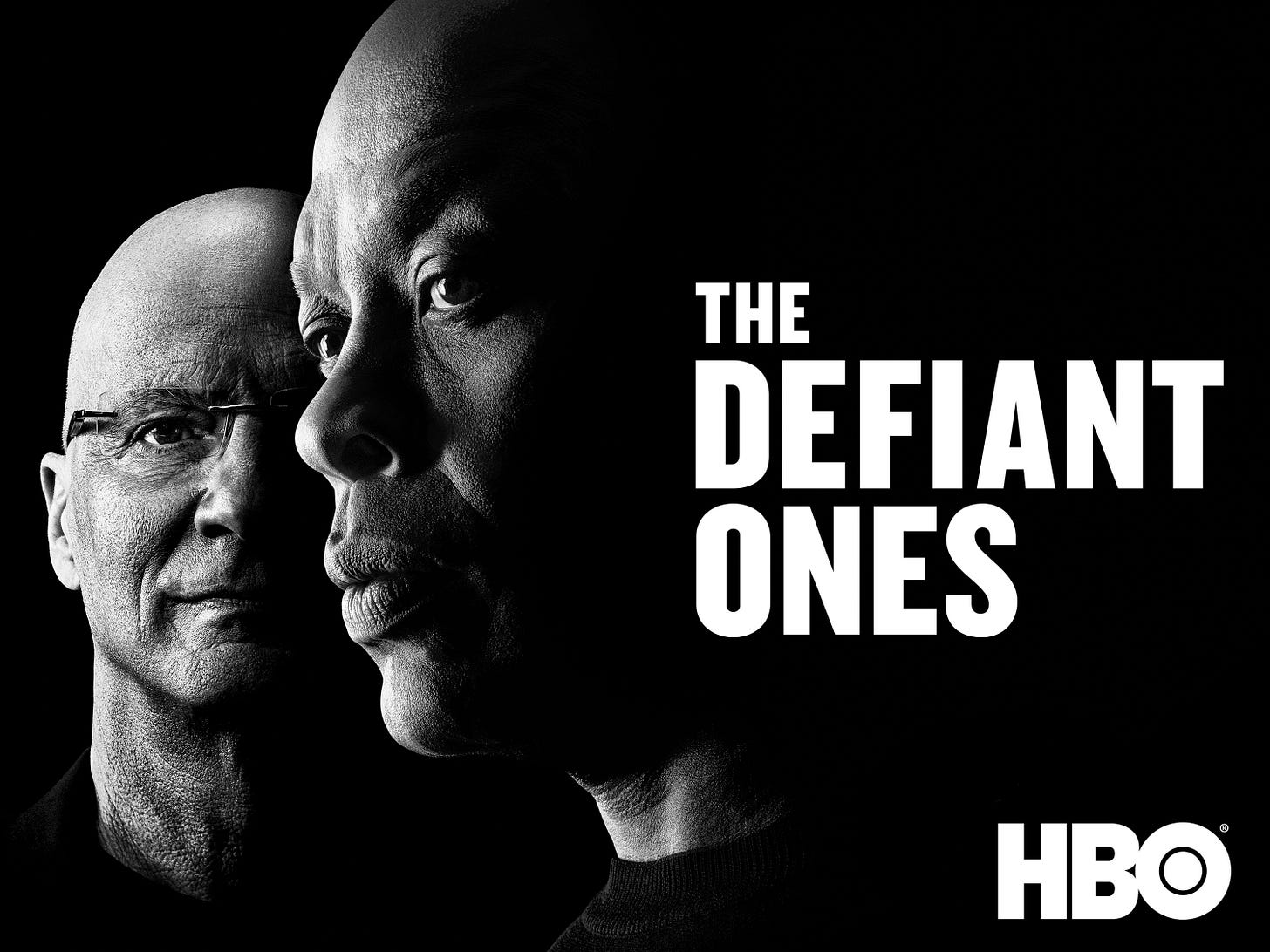Beats by Dre: The Artistry of Business
In 2008, the USA Olympic basketball team, led by LeBron James, stepped off the airplane in Beijing wearing futuristic U-shaped headphones with mysterious lowercase “b’s” on the earcups. They looked fresh, bold, and effortlessly cool. The moment turned heads—and turned the world’s attention to Beats by Dre.
Most people were impressed, seeing it as a stroke of marketing genius—a bold move to launch a new product on the global stage. Dr. Dre, a music legend, had teamed up with LeBron James to create buzz. But if you stopped at the surface, you’d miss the deeper story—a story of artistry, vision, and an obsession with human experience that transformed an entire industry.
Beats by Dre wasn’t just about headphones. It was about creating an intimate connection between artists and listeners—bringing the soul of the studio into everyday life. That vision, born out of frustration and creative integrity, is what I call business artistry: the ability to set a creative vision that begins with human emotions rather than technological capabilities. By prioritizing people first and technology second, we can design products and experiences that truly resonate on an emotional level.
Let’s dive into the artistry of Beats.
The Problem: A Broken Listening Experience
If you’re in your 30s or 40s, you might remember how terrible listening to music used to be in the early 2000s. Headphones were an afterthought commodity. Cheap earbuds flooded the shelves, often bundled with MP3 players or phones as free throwaways. And if you forgot yours, you’d make do with lousy airplane headphones or the tangled remains of something you found at the bottom of your backpack. The sound? Tinny, hollow, and completely disconnected from the music’s emotional core. You heard more of the world around you—chatter, screams, engine noise, white noise—than the music itself. And we accepted it as the standard.

Now, think about the artists behind the music—the ones who spend countless hours crafting lyrics, recording live instruments, layering beats, and pouring their souls into every song. Sometimes, this process takes years. Yet all that work is often funneled through subpar headphones that strip away the nuances and emotions they worked so hard to convey. It’s like trying to experience a Picasso, Rothko, or Robert Irwin installation through a computer screen: diminished, flat, and missing the point entirely.
This wasn’t just a minor inconvenience for Dr. Dre—it felt like a creative offense. As one of the most accomplished producers of his time, Dre couldn’t stand hearing kids listen to his meticulously crafted music on cheap computer speakers or dollar-store earbuds. “We’re spending hundreds of hours in the studio, making sure every sound is perfect,” he told his business partner Jimmy Iovine. “And they’re listening to it on this?”
Even Steve Jobs, who revolutionized portable music with the iPod, admitted that Apple’s white earbuds were never meant to be the gold standard. They were just “starter buds.” But nobody seemed to be asking the big question: What would it take to make music sound as good in someone’s ears as it does in the studio?
That’s where Beats began.
The Vision: Art First, Science Second
When Jimmy Iovine—legendary music producer and co-founder of Interscope Records, who worked with icons like Bruce Springsteen, U2, Lady Gaga, and Eminem—decided, together with Dre, to tackle the headphone market, they didn’t start with technology. They started with human experience. They weren’t interested in audiophile-grade perfection or sound labs full of graphs and charts. They wanted to capture the feel of music: the soul, the bass, the raw intensity. "What if listening to music could be as cool as the music itself?" he asked.
If you’re an entrepreneur looking to fix headphones, your first instinct might be to start with the engineering, right? That’s exactly what Dre and Iovine did. They turned to Bose, the engineering powerhouse renowned for its noise-canceling technology. But it quickly became clear that Bose didn’t share their vision. The engineers approached the project with a purely technical mindset, designing sound systems based on the laws of physics and classical music as the reference point. Their prototypes delivered precise sound—but they were sterile. They lacked the warmth, power, and emotion that defined hip-hop, pop, and other modern genres.
Dre and Iovine realized they had to take a different path. This wasn’t about creating a perfectly engineered product; it was about creating an artistic product. One that didn’t just measure up in a lab, but one that resonated with listeners on a deeply emotional level. As Jimmy later explained, “It’s a human thing, not a math problem,”
For Iovine, the connection between the artist and the listener mattered more than any lab test—and he was right. “Turns out that listeners, like artists, don’t give a shit about audiophile grade; they want their shit to sound good,” he said in the book Two Beats Ahead: What Musical Minds Teach Us About Innovation by Panos A. Panay and Michael Hendrix.
So they flipped the traditional product design process on its head. Instead of starting with science and trying to fit the art into it, they started with the art—the way music feels in a studio—and built the science around it. This approach was radical, but it worked.
This shift in perspective also redefined how Beats approached the product design itself. TJ Grewal, Beats’ head of product, described it best: “I think where that trick comes from, it’s because we’re born more from a right-brain approach to the problem. Product wasn’t cultural before; it was functional.” Beats changed everything by focusing not just on making sound great, but on making sound cool. “We’re not just engineering headphones,” Grewal added. “We’re building culture.”
Before Beats Studio headphones officially debuted in 2008, Jimmy Iovine already had a plan to make them a cultural phenomenon. While the headphones were still in development, he saw the perfect opportunity to get them into the hands of cultural influencers. One of those influencers was LeBron James—a rising star who’d grown up listening to Dr. Dre’s music and was fanatical about sound - for him, music was everything. Iovine made sure James got an early pair while he trained for the 2008 Olympics. James loved them and asked for more—enough to outfit the entire U.S. Olympic basketball team before they left for Beijing (Now that’s marketing genius!). When the team stepped off the plane, each player wearing Beats, the buzz was immediate. Fans weren’t just curious about the headphones—they wanted them.
When Beats headphones debuted in 2008, they weren’t just the new pair of tech headphones—they never intended to be. With their bold design and bass-heavy sound, Beats had made listening to music cool again. For the first time, headphones transcended their functionality—they became fashionable, aspirational, and deeply tied to culture.
But Beats’ success wasn’t just a triumph of marketing. Critics often reduce the brand to its celebrity endorsements, but that view misses the point. The headphones resonated because they were tuned by artists—Dre and Iovine—who understood what music should feel like. "We’re not deaf," Iovine said. "We wanted the soul of the music, the feel of being in a studio."
And apparently, “feeling”—a word the business and tech world often overlooks—has real economic value. As Iovine once explained: “One of the engineers at Apple once asked me what I mean by feel. It’s everything, everything in your life. When you look at a painting, you feel something. You might walk through a gallery and see ten paintings, but only one of them hits you. It’s the same when you hear a great song: you feel something and interpret it inside your head. When it feels right, it feels right.”
That philosophy became the heart of Beats’ success. Within five years, Beats captured 64% of the U.S. premium headphone market. It transformed headphones from a $20 commodity into a $300 cultural phenomenon. By 2012, Beats was defining the category. Its success was so undeniable that in 2014, Apple acquired Beats for $3 billion, making it the largest acquisition in Apple’s history at the time.
The Lesson: Business as Art
This is the essence of what I call business artistry: starting with people, not products. It’s about asking, “What does the human experience demand?” and building technology to meet that vision—not the other way around. Beats didn’t just elevate music; it elevated the act of listening to music.
At the end of the inspiring HBO docuseries The Defiant Ones, in the final episode, after the sale of Beats, Iovine reflects on a critical insight. This is my recollection of what he said: “I don’t understand why we have great designers and great engineers, but we don’t have great designer-engineers.” While those may not have been his exact words, the message is clear: the worlds of creativity and engineering needed to merge. This realization led Dre and Iovine to take action. They founded the USC (University of Southern California) Iovine and Young Academy for Arts, Technology, and the Business of Innovation. And pay attention to what the first word is: Arts.
That’s what makes Beats by Dre more than just a business success. It’s a story of how art can lead and how feelings can create value—not just cultural value, but economic value, too.
So, the next time you think about designing a product, don’t start with the tech specs. Start with the emotion. Start with the soul. That’s the difference between building something functional and building something unforgettable.
Last Thoughts:
If you enjoy Business Artisty and think a friend or a colleague can benefit from it, tell them about it by sharing it.
I’d love to hear from you! Whether it's your thoughts, suggestions, critiques, or even cool stories and ideas, feel free to drop me a note at nir [at] theartian.com or use the comments.
Thanks for reading.
Nir
Just a heads-up: Some links might be Amazon affiliate links.





